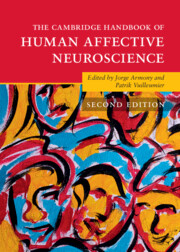Book contents
- The Cambridge Handbook of Human Affective Neuroscience
- Cambridge Handbooks in Psychology
- The Cambridge Handbook of Human Affective Neuroscience
- Copyright page
- Contents
- Figures
- Tables
- Contributors
- Introduction
- Section I Theoretical Models of Emotion
- Section II Measuring Emotional Processes
- Chapter 3 Neuropsychology and Lesion Models
- Chapter 4 Peripheral Physiological Measures of Emotion
- Chapter 5 Functional MRI
- Chapter 6 Mapping the Human Emotion Circuits with Positron Emission Tomography
- Chapter 7 Electro- and Magnetoencephalography
- Chapter 8 The Study of Emotion in Other Animals
- Section III Emotion Perception and Elicitation
- Section IV Emotional Learning and Memory
- Section V Cognition–Emotion Interactions
- Section VI Social Emotions
- Section VII Individual Differences
- Index
- References
Chapter 6 - Mapping the Human Emotion Circuits with Positron Emission Tomography
from Section II - Measuring Emotional Processes
Published online by Cambridge University Press: 16 September 2025
- The Cambridge Handbook of Human Affective Neuroscience
- Cambridge Handbooks in Psychology
- The Cambridge Handbook of Human Affective Neuroscience
- Copyright page
- Contents
- Figures
- Tables
- Contributors
- Introduction
- Section I Theoretical Models of Emotion
- Section II Measuring Emotional Processes
- Chapter 3 Neuropsychology and Lesion Models
- Chapter 4 Peripheral Physiological Measures of Emotion
- Chapter 5 Functional MRI
- Chapter 6 Mapping the Human Emotion Circuits with Positron Emission Tomography
- Chapter 7 Electro- and Magnetoencephalography
- Chapter 8 The Study of Emotion in Other Animals
- Section III Emotion Perception and Elicitation
- Section IV Emotional Learning and Memory
- Section V Cognition–Emotion Interactions
- Section VI Social Emotions
- Section VII Individual Differences
- Index
- References
Summary
Positron emission tomography (PET) is the most sensitive technique for imaging of human physiology and molecular pathways in vivo. Here we provide an overview of PET instrumentation and modelling and illustrate how different PET techniques can be used for mapping the molecular basis of the human emotion circuit. We first cover the principles of PET imaging and the most common imaging targets, modelling methods, and experimental designs in brain PET. We then describe how metabolic studies and neuroreceptor mapping of the endogenous dopamine, opioid, serotonin, and cannabinoid systems have contributed to our understanding of the emotional brain. Finally, we review the recent state-of-the art developments in PET-fMRI and total-body PET, and discuss how these techniques can transform the landscape of systems-level biological imaging of the emotion circuits across the brain and periphery.
Information
- Type
- Chapter
- Information
- The Cambridge Handbook of Human Affective Neuroscience , pp. 118 - 140Publisher: Cambridge University PressPrint publication year: 2025
References
Accessibility standard: WCAG 2.0 A
Content Navigation
Allows you to navigate directly to chapters, sections, or non‐text items through a linked table of contents, reducing the need for extensive scrolling.
Provides an interactive index, letting you go straight to where a term or subject appears in the text without manual searching.
Reading Order & Textual Equivalents
You will encounter all content (including footnotes, captions, etc.) in a clear, sequential flow, making it easier to follow with assistive tools like screen readers.
You get concise descriptions (for images, charts, or media clips), ensuring you do not miss crucial information when visual or audio elements are not accessible.
You get more than just short alt text: you have comprehensive text equivalents, transcripts, captions, or audio descriptions for substantial non‐text content, which is especially helpful for complex visuals or multimedia.
Visual Accessibility
You benefit from high‐contrast text, which improves legibility if you have low vision or if you are reading in less‐than‐ideal lighting conditions.
Structural and Technical Features
You gain clarity from ARIA (Accessible Rich Internet Applications) roles and attributes, as they help assistive technologies interpret how each part of the content functions.
